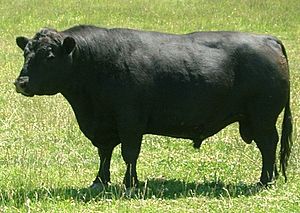Australian Lowline facts for kids

Bull
|
|
| Conservation status | FAO (2007): no data |
|---|---|
| Other names |
|
| Country of origin | Australia |
| Standard | Australian Lowline Cattle Association |
| Use | beef |
| Traits | |
| Weight |
|
| Height |
|
| Coat | solid black, occasionally solid red |
| Horn status | polled |
|
|
The Australian Lowline is a special type of small cattle from Australia. These cows and bulls are raised for their meat, which is called beef. They are naturally polled, which means they don't have horns.
This breed was created through a process called selective breeding. This is when people choose animals with certain traits to have babies, hoping those traits will be passed on. The Australian Lowline came from black Angus cattle that were part of a science experiment in New South Wales, Australia. Even though they are very small, they are not considered a "dwarf" breed.
Contents
How the Lowline Breed Started
The story of the Australian Lowline began in 1929. The Department of Agriculture in New South Wales started a herd of Angus cattle at a research center called Trangie. They brought in cattle from Canada, the United States, and the United Kingdom. By 1964, they stopped adding new cattle to this special herd.
Around that time, scientists at Trangie began different research projects. In 1974, they started a big experiment. They wanted to see if cows that grew faster made more money. They also wanted to know if smaller animals were better at turning grass into meat.
The Three Herds Experiment
For this experiment, the scientists made three separate groups of cattle:
- High Line: This group had animals that grew very fast in their first year.
- Low Line: This group had animals that grew slowly.
- Control Line: This group was chosen randomly and used as a comparison.
The Low Line herd started with 85 cows and some young bulls. No new cattle were added to this group after 1974. Eventually, this herd grew to more than 400 animals. To make sure the weather didn't affect the results, some cattle were also raised in other parts of Australia. The experiment lasted for 19 years. By the end, the Low Line cattle were about 30% smaller than the High Line group.
Becoming a New Breed
When the experiment finished in the early 1990s, the Lowline cattle were sold at an auction. People who bought them loved their small size and good qualities. In 1992, a group of breeders formed the Australian Lowline Cattle Association. They wanted to keep the breed going and help it grow. The first official list of Lowline cattle was published in 1993, showing 150 cows and 36 bulls.
Today, Australia is the main country that reports having Lowline cattle. However, the breeders' association has members in other countries like Canada, New Zealand, the United Kingdom, and the United States.
What Makes Lowlines Special?
The Australian Lowline is one of the smallest cattle breeds. They are not affected by dwarfism, which is a genetic condition that can cause very small size. Lowline bulls are usually about 110 cm (43 inches) tall, and cows are about 100 cm (39 inches) tall.
When Lowline calves are born, they are very small, usually weighing around 22 kg (48 pounds). Some can even be as light as 14 kg (30 pounds)! Their coats are usually solid black, but sometimes they can be solid red.
These cattle are naturally polled, meaning they don't have horns. They are also known for being very calm and easy to handle. Lowlines can live well in many different climates. The cows have an easy time giving birth and produce plenty of milk for their babies.
Compared to larger cattle, Lowlines cause less damage to grassy fields. They also don't need very tall or strong fences to keep them in.
What Are Lowlines Used For?
Australian Lowline cattle are raised mainly for their beef. Their meat is known for being well-marbled, which means it has small streaks of fat throughout. This marbling makes the meat very tasty. When the cattle are processed, a high amount of their body weight turns into usable meat.

